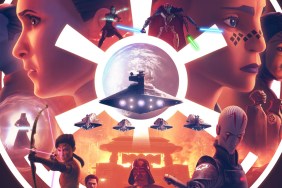
Over the weekend Monsters vs. Aliens destroyed the box-office to the tune of an estimated $58.2 million. As a result the New York Times ran a headline saying “3-D Helps Propel ‘Monsters’ Success”. Inside the article Brooks Barnes mentions the $58 million but says “a deeper look at the numbers indicates that 3-D is the story.” Barnes continues with this ‘graph:
The movie opened on 7,000 screens, including Imax screens, of which only 2,100 were equipped with 3-D technology. About 56 percent of the movie’s weekend total came from those limited 3-D screenings, according to Paramount, and they carried premium prices of up to $4 atop the standard admission. So about 30 percent of the screens delivered 56 percent of the gross, indicating that audiences sought out the format.
Next comes a quote from Anne Globe, the DreamWorks chief of marketing and consumer products saying, “We really feel this is proof of concept for this new style of 3-D.”
This is where I am at a loss. Does this prove anything other than the fact audiences would rather see a movie made in 3-D in 3-D? Going even further, what exactly does 3-D add to a movie?
In my review of Monsters vs. Aliens I said the 3-D was “fantastic” but I added to that saying “I am still not sure I see the overall value.” I enjoyed Monsters vs. Aliens for the entertainment value I got out of it. The 3-D factor carried no weight in my review. As a matter of fact I am more inclined to agree with Roger Ebert who said in his MvA review, “3-D is a distraction and an annoyance.” Hard to argue with that considering something “cool” in 3-D immediately takes you out of the story and maybe it’s just me, but those glasses are a theatrical nightmare. No matter where I am sitting I can see the aisle lighting reflected in my glasses and oftentimes have to put a hand up to deflect the glare.
Mick La Salle at the “San Francisco Chronicle” echoes my statements even though he disagrees with my overall opinion of the film saying, “The cool stuff – like 3-D and collapsing bridges – may get filmmakers halfway there, but to make it all the way home, they need the usual movie elements, like a good story and vivid characters.”
Betsy Sharkey at the “Los Angeles Times” also feels Monsters vs. Aliens “doesn’t need [the 3-D features] to work as a film.” She continues saying, “[They] never feel like anything more than extras that have been thrown into the mix just because the filmmakers have the power tools to do it.”
In an effort to present both sides, the only other review I saw commenting to any length on the 3-D in the film was Peter Howell’s at the Toronto Star in which he said the 3-D “draws you in without smacking you in the face, apart from an opening paddleball wallop.” If that is viewed as a successful comment I wonder what his follow-up will be read as when he says, “Viewers in traditional 2D – and there will be plenty of those – needn’t feel stoppered by lack of an eye-popper.” Once again I ask, What good is it serving?
So outside of dazzling the eye and possibly distracting the viewer from what may in fact be a lesser quality film what benefit do we get from seeing what has always been a flat format in 3-D?
An intriguing piece over at “TIME” by Richard Corliss is headlined saying “3D or Not 3D: That Is the Question“. The article looks at all the hoopla surrounding all the 3-D films coming out this year and how Hollywood is abuzz with chatter saying 3-D is the next big thing. The biggest “hold up” moment of the article, though, is a link to a 1990 “TIME” article headlined “Grab Your Goggles, 3-D Is Back!” which is then followed by a link to TIME’s top ten movie gimmicks (a top ten I should have done instead of this editorial).
If you read that 1990 piece from TIME you will see a lot of similar things being said about the format now, including chatter of 3-D on TV, something I think we can all agree has been a major disappointment every time it has been tried.
So you tell me, does 3-D add anything to a movie for you and, if so, what?
Upcoming 3-D films set for 2009 include Pixar’s Up, Fox’s Ice Age: Dawn of the Dinosaurs, Final Destination: Death Trip, Disney’s A Christmas Carol and, of course, James Cameron’s Avatar. I know Avatar is one that is on everyone’s list of must see movies, but just how much does the 3-D factor weigh into that anticipation?










